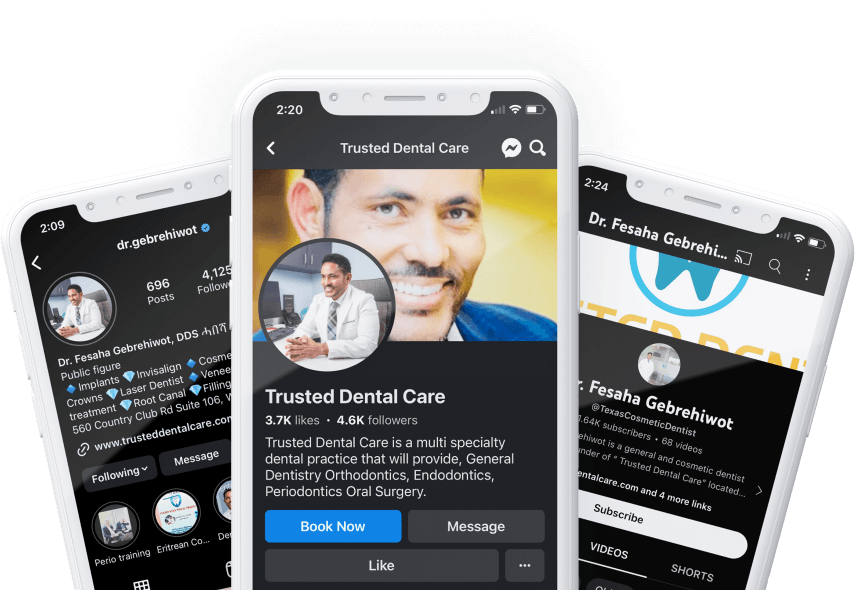Replace Missing Teeth with an Implant-Supported Bridge!
Tooth loss can significantly impact oral health, self-esteem, and quality of life. Implant-supported bridges offer an effective, long-lasting solution for those missing multiple teeth. Unlike a traditional bridge that relies on adjacent teeth for support, an implant-supported bridge is anchored directly into the jawbone, providing superior stability and functionality.
To schedule a consultation at Trusted Dental Care, contact our dental office in Wylie, TX, today by calling(214) 702-0446.

What Are Implant-Supported Bridges?
Implant-supported bridges consist of dental implants, which are titanium posts surgically inserted into the jawbone, and the bridge itself, which replaces the missing teeth. The implants act as artificial tooth roots, providing a secure foundation for the bridge. This type of restoration is particularly beneficial for patients who have lost several teeth in a row.
A dental implant bridge has four parts:
- Titanium Posts: These are the base of your restoration. They’re surgically placed into the jawbone and act as a natural tooth root, stimulating the jawbone.
- Abutment: A small metal connector is attached to the implant posts.
- Porcelain Dental Crown: Dental crowns are customized restorations placed over the abutments to give you a natural-looking smile.
- Pontic Teeth: The prosthetic teeth are cemented to the neighboring porcelain dental crowns.
Types of Implant Bridges
There are various implant-supported restorations, including:
- Fixed Implant Bridge: A type of bridge that’s permanently attached to dental implants. It can’t be removed by the patient and is designed to function and feel like natural teeth.
- Removable Implant Bridge: This type of dental bridge is designed to be removed by the patient for cleaning and maintenance. It’s attached to the implants with connectors that can be easily unscrewed.
- Full Arch Implant-Supported Bridge: This type of bridge is used to replace an entire arch of missing teeth in the upper and lower jaws. It’s anchored to several dental implants and is a good option for patients who have lost most or all of their teeth in one arch.
- Partial Arch Implant-Supported Bridge: A dental bridge used to replace several teeth in a row. It’s anchored to two or more dental implants and can be used to replace a small section of lost teeth.
- Hybrid Implant Bridge: Combines the benefits of a fixed and removable bridge. It’s designed to be permanently attached to the implants but can be removed by the dentist for maintenance and cleaning.

Implant-Supported Bridge Benefits
Enhanced Stability and Functionality
Implant-supported bridges are firmly anchored to the jawbone, providing a stable and secure fit. This stability allows for improved chewing and speaking abilities compared to removable dentures or traditional bridges.
Preservation of Jawbone Health
When teeth are lost, the jawbone can begin to deteriorate due to lack of stimulation. Dental implants mimic the function of natural tooth roots, stimulating the jawbone and preventing bone loss.
Natural Appearance
An implant bridge is designed to look and feel like natural teeth. They’re custom-made to match the color, shape, and size of your existing teeth, ensuring a seamless and aesthetically pleasing smile.
Longevity and Durability
With proper care, implant bridges can last a lifetime. Unlike a traditional bridge, which may need replacement every 5 to 10 years, a dental implant is a long-term solution.
The Implant-Supported Bridge Procedure
- Initial Consultation and Examination: The process begins with a thorough examination by our dentist or an oral surgeon. This includes X-rays, 3D imaging, and a review of your medical and dental history to determine if you’re a suitable candidate for dental implants.
- Treatment Planning: A detailed treatment plan is created, tailored to your specific needs. This plan outlines the number of implants required, the placement locations, and the design of the bridge.
- Implant Placement Surgery: During the surgical procedure, titanium posts are inserted into the jawbone at predetermined locations. This surgery is typically performed under local anesthesia, though sedation options are available for those who need them.
- Healing and Osseointegration: After the implants are placed, a healing period of 3 to 6 months is necessary for osseointegration, where the implants fuse with the jawbone. Temporary restorations may be provided during this time.
- Abutment Placement: Once the implants have fully integrated with the jawbone, abutments (connectors) are attached to the implants. These abutments will hold the final bridge in place.
- Bridge Fabrication and Placement: Impressions of your mouth are taken to create a custom-made bridge. Once ready, the bridge is secured to the abutments, completing the restoration.
Candidacy for Implant-Supported Bridges
To qualify for implant-supported bridges, you need:
- Adequate Bone Density
- Good Oral Health
- Commitment to an Oral Hygiene Routine
- Non-smoking (preferred)
Costs of Implant-Supported Bridges
The costs of an implant-supported bridge can vary between $5,000 to $15,000. Your cost will vary depending on various factors, including:
- Number of Implants: The cost will depend on how many dental implants are needed to support the bridge. Typically, each missing tooth that needs to be replaced with an implant-supported bridge requires an individual implant. The more implants required, the higher the cost.
- Type of Material: The materials used for the bridge can affect the cost. Options include porcelain, zirconia, or a combination of materials. High-quality materials may be more expensive but can also offer better aesthetics and durability.
- Geographic Location: The cost of dental procedures can vary significantly depending on where you live. Dental services tend to be more expensive in urban areas and regions with a higher cost of living.
- Dentist’s Experience: The experience and expertise of the dentist or oral surgeon performing the procedure can impact the cost. More experienced professionals may charge higher fees.
- Additional Procedures: Sometimes, patients may require additional procedures before or during implant placement, such as bone grafting or sinus lifts. These procedures can add to the overall cost.

Frequently Asked Questions
Implant-supported bridges can last a lifetime, but their lifespan depends on factors such as the quality of the dental implant, the patient’s oral hygiene routine, and overall health. Regular dental checkups and cleanings must be scheduled to help increase the longevity of your implant bridge.
There’s no age limit for implant-supported bridges. However, implant bridges aren’t a treatment option normally recommended for patients whose jaws are still developing. Older patients may have a lower jawbone density, which can affect the success of the implant. In these cases, implant-supported bridges aren’t always the best treatment option for replacing missing teeth.
In general, an implant bridge can replace anywhere from two to six missing teeth in a row. If a patient has more than six missing teeth in a row, multiple dental implant-supported bridges or other tooth replacement options may be needed to fully restore their smile. The number of dental implants needed to support the bridge will also depend on the number of missing teeth being replaced.
Are Implant-Supported Bridges Right for You? Find Out from Our Wylie Dentist!
If you’re missing multiple teeth, it’s time to find a dentist with the best replacement treatment option. To learn more about dental implant-supported bridges, contact our Wylie dentist by calling(214) 702-0446. We’ll help you better understand your treatment options to improve your oral health and your smile’s appearance.